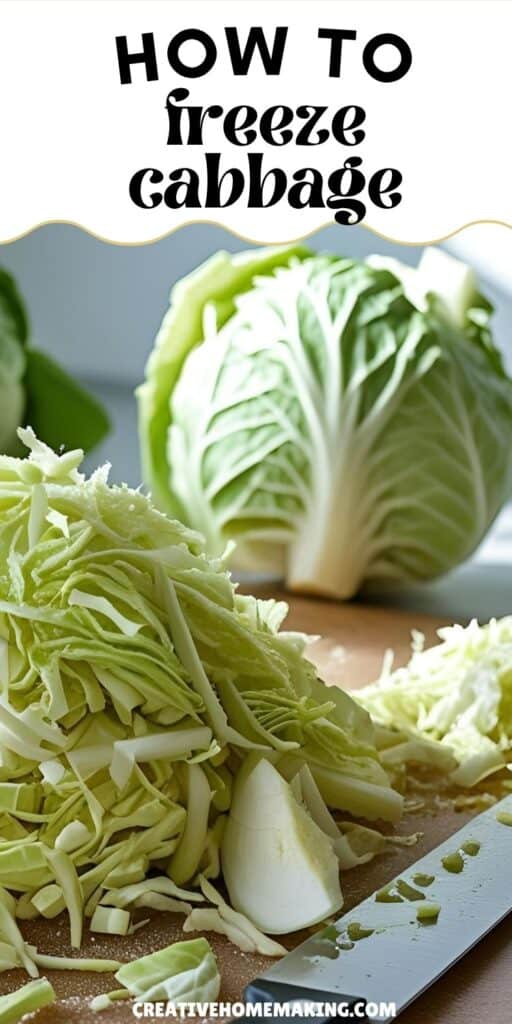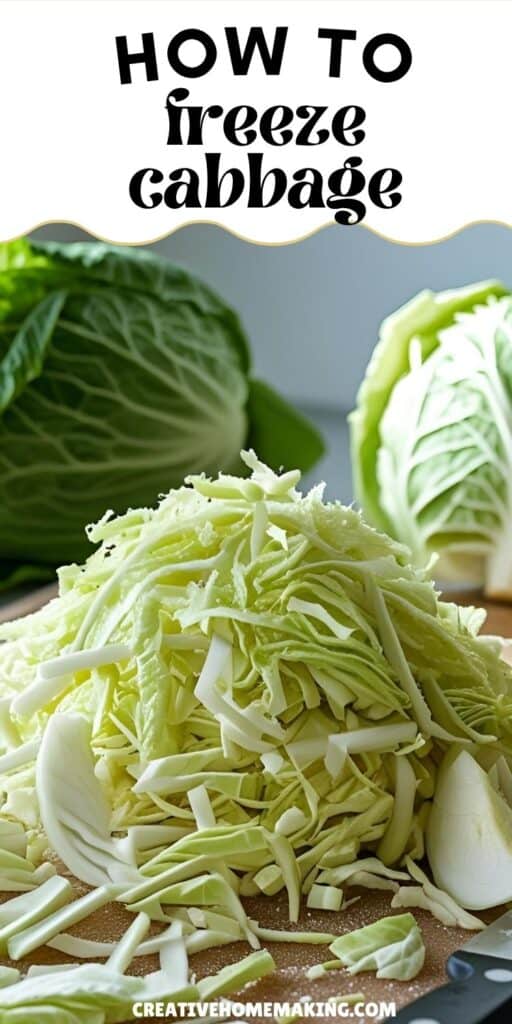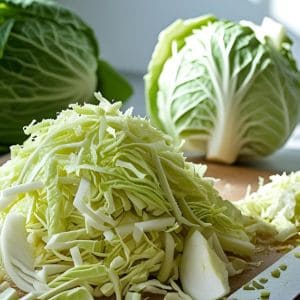Freezing cabbage is a simple way to keep it fresh and ready to use whenever you need it. You can freeze cabbage by washing it, cutting it into leaves, wedges, or shreds, blanching it briefly in boiling water, cooling it quickly, and then storing it in freezer bags. This process helps keep the cabbage’s flavor and texture intact for several months.
This post may contain affiliate links.
Whether you want to add it to soups, stews, or salads, frozen cabbage can save you time and reduce waste. You’ll learn easy steps to prepare your cabbage for freezing so it tastes great when thawed. With a little care, you can enjoy fresh cabbage long after the harvest.
Related Article: How to Freeze Shredded Zucchini: Easy Tips and Tricks

Step-By-Step Guide to Freezing Cabbage
Freezing cabbage keeps it fresh and ready to use whenever you need. You’ll learn how to pick the best cabbage, get it ready, blanch if needed, and freeze it properly to keep the best texture and flavor.
Selecting Fresh Cabbage
Choose cabbage that feels firm and heavy for its size. Look for leaves that are crisp and free from yellow spots or bruises. Avoid heads with wilting or slimy leaves because they won’t freeze well.
Green, red, or savoy cabbage all freeze well, but make sure the leaves are tightly packed. Smaller heads often taste sweeter and freeze better than large, mature ones. Freshness matters most since freezer storage won’t improve bad cabbage.
Related Article: How to Freeze Cherry Tomatoes: A Quick and Easy Guide
Preparing Cabbage for Freezing
Start by rinsing the whole head under cold water. Remove any damaged or outer wilted leaves. You can freeze cabbage whole, shredded, or cut into wedges depending on how you plan to use it later.
For cleaner freezing, soak cabbage in cold water for 2-3 hours to remove dirt and pesticides. After washing, dry the cabbage well with a towel or let it air-dry. Moisture can cause ice crystals and damage the texture during freezing.

Blanching Methods
Blanching is a quick boil or steam that stops enzymes from breaking down the cabbage. This helps keep color, flavor, and texture during freezing.
To blanch with boiling water:
- Bring a large pot of water to a boil.
- Place cabbage pieces in the boiling water for 1-2 minutes.
- Quickly remove and cool cabbage in ice water for the same time.
- Drain and dry.
To blanch by steaming:
- Place cabbage in a steamer basket over boiling water.
- Steam for 2-3 minutes.
- Cool in ice water and dry.
Blanching is recommended but you can freeze raw cabbage if you plan to cook it directly after thawing.
Related Article: How to Freeze Rhubarb: A Quick and Easy Guide
Freezing Cabbage Leaves and Pieces
Lay cabbage leaves or cut pieces in a single layer on a baking sheet. Freeze them for 1-2 hours until firm. This prevents the pieces from sticking together later.
Once frozen, pack the cabbage into airtight freezer bags or containers. Remove as much air as possible to avoid freezer burn. Label containers with the date.
You can freeze cabbage whole, leaves, wedges, or shredded depending on your cooking plans. Frozen cabbage is best used within 10-12 months for quality.
Tips for Storing and Using Frozen Cabbage
Proper storage helps keep your frozen cabbage fresh and tasty for longer. Knowing how to thaw it correctly protects its texture and flavor. Using frozen cabbage in the right recipes makes your meals simple and delicious.
Best Storage Practices
Store frozen cabbage in airtight containers or freezer bags to prevent freezer burn. Remove as much air as possible before sealing. Label the package with the freezing date so you can keep track.
Keep your freezer at 0°F (-18°C) or below to maintain quality. Frozen cabbage is best used within 8 to 12 months for taste and texture. Avoid refreezing thawed cabbage since it can become watery and lose flavor.
If you froze cabbage in pieces, spread them out in the bag or container to help cool evenly and prevent clumps. This way, you can grab just the amount you need without thawing the whole batch.
Thawing Cabbage Properly
Thaw frozen cabbage in the refrigerator overnight when you have time. This helps keep it firm and prevents sogginess. For quicker thawing, place the frozen cabbage in a colander under cold running water.
If you’re adding cabbage to hot dishes like soups or stews, you can add it frozen without thawing. Just be sure to adjust cooking time slightly.
Avoid thawing cabbage at room temperature. It can get mushy and lose its crunch when left out too long. Always use thawed cabbage within 1-2 days.
Recipes Using Frozen Cabbage
Frozen cabbage works well in soups, stews, stir-fries, and casseroles. It holds up better when cooked slowly or with liquid, which helps keep it tender.
Try adding frozen cabbage directly to dishes like vegetable soup or chili. You can also sauté it with garlic and onions for a quick side dish.
Avoid using frozen cabbage raw in salads since it loses crispness after freezing. Instead, save fresh cabbage for salads and use frozen for cooked recipes.
Follow my canning and preserving board on Pinterest.




